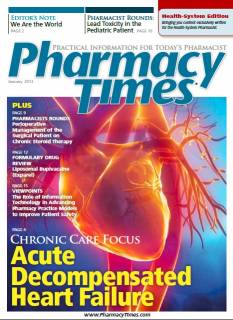Publication
Article
Pharmacy Practice in Focus: Health Systems
Lead Toxicity in a Pediatric Patient
Author(s):
Patient Case
AN is a 3-year-old male with a past medical history of pica and developmental speech delay. The patient presented to the emergency department following a routine blood lead level (BLL) obtained at his pediatrician’s office, which was 109 mcg/dL; a repeat level was 131 mcg/ dL. AN began to experience abdominal pain, vomiting, and constipation 2 days prior to presentation. Abdominal imaging demonstrated the presence of foreign bodies, possibly lead paint chips, throughout the colon. A complete blood count revealed the following values: hemoglobin 9.8 g/dL, hematocrit 30.2%, MCV 75 fL. The patient’s zinc protoporphyrin level was 714 mcg/dL and G6PD deficiency was ruled out. The clinical pharmacist was consulted regarding the most effective treatment option.
Answer
Lead toxicity (plumbism) most commonly occurs in pediatric patients following exposure to lead paint chips or dust. Children are at increased risk of lead toxicity due to greater absorption of ingested lead, mobilization of lead deposits in soft tissue, an immature blood brain barrier, and developing organ systems.1,2 Lead levels ≥10 mcg/ dL are known to cause IQ reduction.1,2 Recent studies, however, have demonstrated even greater rates of cognitive impairment with lead levels <10 mcg/ dL, including those as low as 1 mcg/ dL.3 In January 2012, the Centers for Disease Control and Prevention modified their recommendations to encourage additional monitoring of children with a BLL ≥5 mcg/dL, as adverse neurologic effects may occur at any lead level.4
Children with elevated blood lead levels are often asymptomatic. Patients with a BLL ≥60 mcg/dL may experience headaches, abdominal pain, constipation, agitation, and somnolence. Encephalopathy and seizures may occur with a BLL ≥100 mcg/dL.1 When a patient’s BLL exceeds 45 mcg/ dL, a complete blood count, iron studies, and zinc protoporphyrin (ZPP) or free erythrocyte protoporphyrin (FEP) should be obtained. Lead disrupts heme synthesis, of which erythrocyte protoporphyrin is a precursor, resulting in microcytic, hypochromic anemia. An elevated ZPP or FEP level indicates chronic lead exposure.5
Chelation therapy is indicated for patients with a BLL ≥45 mcg/dL.1,2 Calcium disodium EDTA is utilized for patients with a BLL ≥70 mcg/dL and may be administered intravenously at a dose of 50 mg/kg/day or 1000 to 1500 mg/m2 /day as a continuous infusion over 8 to 24 hours for a total duration of 5 days. Calcium disodium EDTA mobilizes lead from bones and forms lead complexes that may induce encephalopathy and seizures. Due to the neurologic risks of calcium disodium EDTA monotherapy in patients with a BLL ≥70 mcg/dL, it must be used in combination with and initiated 4 hours after the first dose of dimercaprol.1,2 Among patients with a BLL ≥100 mcg/ dL, concurrent use of calcium disodium EDTA and dimercaprol reduces lead levels more rapidly than calcium disodium EDTA alone.2 Dimercaprol 25 mg/ kg/day or 450 mg/m2 /day divided every 4 hours is administered intramuscularly for a minimum of 3 days and may be discontinued when the BLL is below 50 mcg/dL. Dimercaprol is contraindicated in patients with glucose-6-phosphate deficiency.1,2 Following initial chelation therapy, lead redistributes from bones, necessitating further BLL monitoring. A repeat lead level of 45 to 69 mcg/ dL may be treated with oral chelators (succimer or penicillamine) or calcium disodium EDTA monotherapy. If the BLL exceeds 70 mcg/dL, dimercaprol and calcium disodium EDTA therapy should be repeated, with a minimum of 2 days between treatment courses, until the BLL is below 45 mcg/dL.2 AN was successfully treated with a 5-day course of calcium disodium EDTA and dimercaprol, after which his BLL was 26 mcg/dL.
Two weeks later, AN’s lead level was 52 mcg/dL, requiring further outpatient treatment with succimer. Daily iron supplementation was also initiated following completion of chelation therapy, as iron decreases absorption of ingested lead.2
Michelle Rychalsky, PharmD, is a pediatric clinical pharmacist at Yale-New Haven Hospital in New Haven, Connecticut, where she works as a neonatal intensive care unit pharmacist and is involved in establishing protocols and preparing for an upcoming pharmacy information system upgrade.
References







